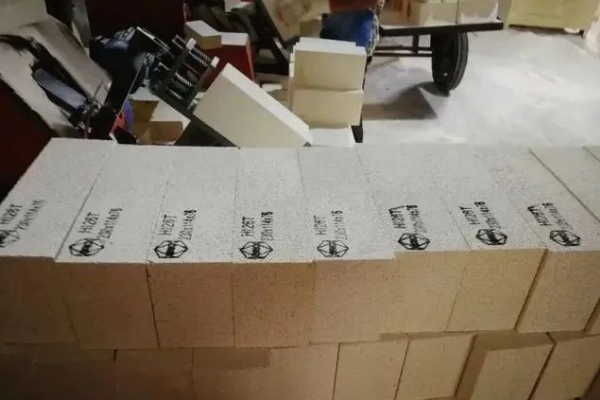
Классификацию легких огнеупоров можно разделить по химическому составу., использовать температуру, существование различных форм, и микроструктура.
Легкие огнеупоры – это огнеупоры с низкой теплопроводностью и малой теплоемкостью., также известный как изоляционные огнеупоры.
Легкие огнеупоры обычно характеризуются высокой пористостью и низкой объемной плотностью и часто называются теплоизоляционными огнеупорами..
Традиционно, легкие огнеупоры имеют плохую стойкость к эрозии., сила, и устойчивость к истиранию, поэтому они обычно не используются непосредственно в качестве материалов для рабочей поверхности., но располагаются за рабочей поверхностью в качестве изолирующего слоя. Однако, чем ближе легкий огнеупорный материал к забою, тем лучше его теплоизоляционный эффект.
С улучшением требований к энергосбережению и сокращению выбросов, разработка и исследование легких огнеупорных материалов с высокой прочностью, стойкость к высоким температурам, и эрозионная стойкость, который можно использовать непосредственно в забое, были широко подчеркнуты.
Классификацию легких огнеупоров можно разделить по химическому составу., использовать температуру, существование различных форм, и микроструктура.
По различному химическому минеральному составу, легкие огнеупоры можно разделить на легкие огнеупорные материалы из глинозема., легкие огнеупорные материалы с высоким содержанием глинозема, муллитовые легкие огнеупорные материалы, легкие кремнеземные огнеупорные материалы, глиняные легкие огнеупорные материалы, вермикулитовые легкие огнеупорные материалы и легкие огнеупорные материалы из диатомита.
Легкие огнеупоры также можно разделить в зависимости от использования температуры., применение легких огнеупоров – это температура, при которой усадка при повторном обжиге не превышает 1% к 2%.
По использованию температурного деления, легкие огнеупоры можно разделить на низкотемпературные легкие огнеупоры. (использовать температуру <600 ℃), среднетемпературные легкие огнеупоры (использовать температуру 600 ~ 1200 ℃), и высокотемпературные легкие огнеупоры (использовать температуру > 1200 ℃). Высокотемпературные легкие огнеупоры являются наиболее часто используемыми теплоизоляционными материалами в промышленных печах..
По наличию формы деления, легкие огнеупоры можно разделить на порошкообразные гранулированные, сформированный, волокно, и композитные легкие огнеупоры.
Кроме того, по конструктивным особенностям, легкие огнеупоры также можно разделить на газофазные сплошного структурного типа., твердофазный сплошной структурный тип, и твердофазный и газофазный сплошной структурный тип.
Легкие огнеупоры изготавливаются по основному принципу снижения теплопроводности материала..
Поскольку легкие огнеупоры содержат много пустот, формой теплопередачи через легкие огнеупоры является твердофазная и газофазная теплопередача..
Твердофазная форма теплопередачи – это, главным образом, проводимость., тогда как газофазная форма теплопередачи более сложна: тепло из высокотемпературной зоны во внутренние процессы изоляционных материалов, в процессе соприкосновения с воздушными отверстиями до того, как роль теплопроводности происходит в твердой фазе.
После встречи с порами, пути теплопередачи становятся двумя и продолжают передаваться через твердую фазу и поры.. Для той части теплопередачи, которая продолжается через твердую фазу, расстояние маршрута теплопередачи значительно увеличивается за счет изменения направления проводимости, т.е., термическое сопротивление становится больше.
Тепло, передаваемое через устьица, осуществляется через газ., конвекционная теплопередача, и радиационный теплообмен.
(1) Теплопроводность: обычно, теплопроводность газа очень мала, а большую часть газа во внутренних порах легких огнеупорных материалов составляет воздух. Теплопроводность воздуха значительно меньше, чем у твердых материалов.. Поэтому, тепло, проводимое через поры, очень мало.
(2) Конвективный теплообмен: конвективный теплообмен происходит преимущественно за счет потока газа. Поскольку у большинства легких огнеупоров поры очень малы, поток воздуха в поре будет сильно ограничен, и расход газа очень мал, поэтому теплопередача тоже очень мала.
Чем меньше отверстие поры, тем меньше текучесть воздуха в поре, и тем меньшее количество жидкости переносится конвекцией.
Когда апертура поры меньше поры молекул газа при движении свободного пробега, Молекулы газа перестают двигаться, больше нет тепла за счет передачи конвекции газа.
(3) радиационная теплопередача: потому что большая часть легкого тугоплавкого порового газа приходится на воздух, а молекулы газа в основном состоят из N2 и O2. они представляют собой симметричные молекулярные структуры двухатомного типа..
Этот вид молекул газа поглощает и испускает излучение, способность относительно плохая..
Поэтому, радиационный теплообмен через пору осуществляется в основном через высокотемпературную стенку поры к низкотемпературной стенке радиации. Но в целом, радиационный теплообмен через поры не очень велик.
Видно, что наличие пор в способности легкой огнеупорной теплоизоляции является большим подспорьем., во многих случаях, При проектировании теплоизоляционных материалов основное внимание уделяется введению пор для проведения.
С октября, Цены на глинозем продолжают расти, and China's largest bauxite importer - a…
Первый, Высокоглиноземистый кирпич: The Leader In High Temperature Refractories As a leader in high-temperature…
The application of refractory bricks in the kiln immediately endangers the operation rate of the…
Analysis Of The Causes Of Common Quality Problems In Tunnel Kiln Construction And Measures To…
Corundum quality refractory castables are made from corundum to the new jade refractory insulation material…
Анализ алюминиево-кремниевого огнеупорного сырья проф.. Li Yong of the University of Science and…